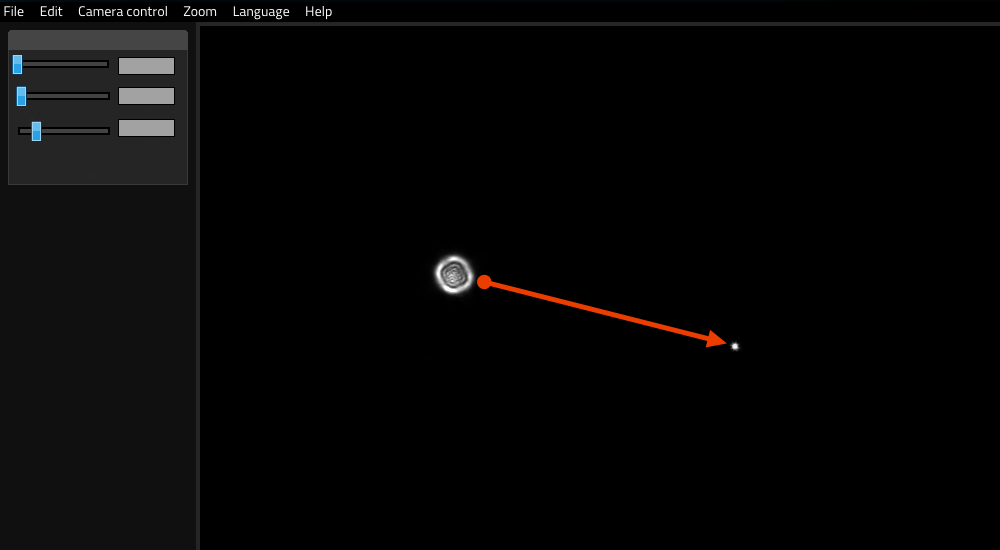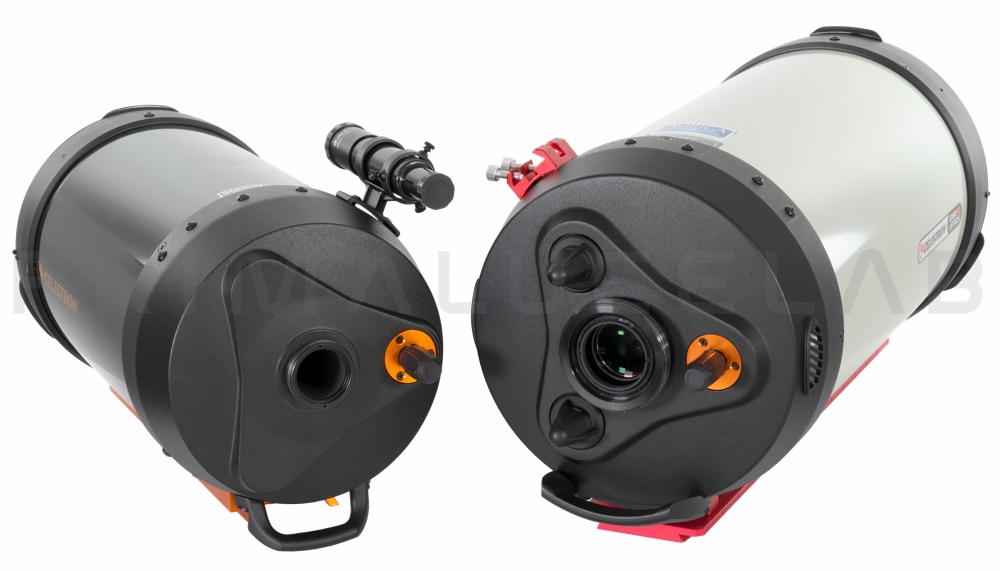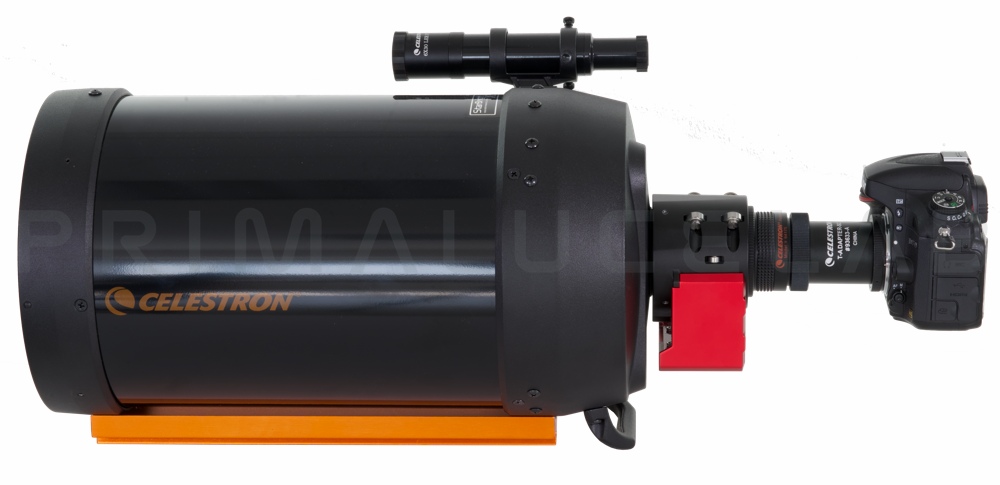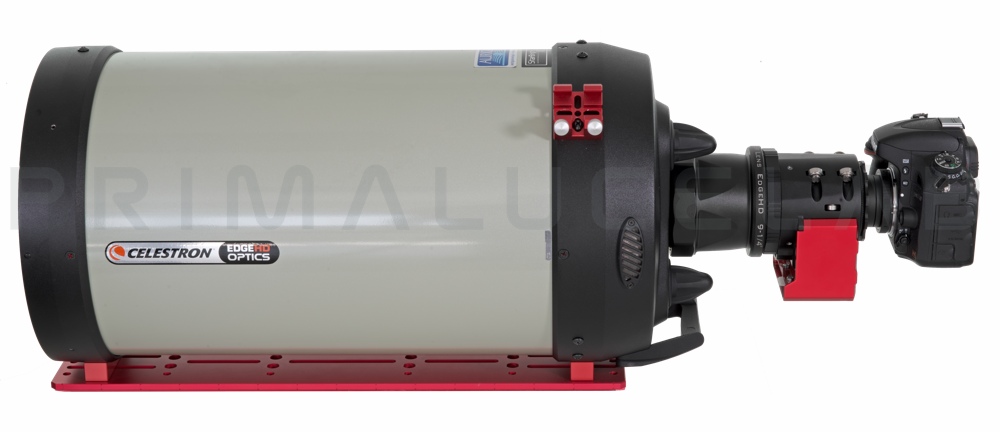If you are looking for a focuser for Schmidt-Cassegrain or for aplanatic telescopes (like EdgeHD by Celestron), ESATTO is the perfect solution! In this article we see how ESATTO improves focus and how it installs on these telescopes. Schmidt-Cassegrains and EdgeHD are great instruments because they combine high performance with ease of use (for example, they are simple to collimate) and portability (they are among the most compact optical tubes, although the diameter can also be large). However, the internal focuser of these telescopes (which allows focusing by moving the primary mirror) generates image shift and mirror flop problems that we can now avoid thanks to ESATTO.
Problems caused by internal focuser of Schmidt-Cassegrain or EdgeHD telescopes
Image shift is generated when the focus with the internal focuser generates a displacement of the image: this problem is evident during high-magnification astrophotography of planets and the Moon when recovered object can even be moved out of the sensor field of view. By using ESATTO as focuser for Schmidt-Cassegrain or EdgeHD, we can avoid the image shift since we focus with the external focuser (and no longer using the internal stock focuser). Since ESATTO has a precision micrometric control with a 0.04 micron resolution, we can also focus with much greater precision than you have with standard manual focusing, without introducing vibrations during focusing (since we don’t touch the telescope to focus but we control ESATTO with a USB connection from EAGLE or an external Windows computer or through the Virtual HandPad with WiFi connection from smartphone or tablet).
Mirror flop is the displacement of the primary mirror which tends to move due to its own weight and it’s a problem for long-exposure astrophotography of deep-sky objects. This problem was fixed by Celestron EdgeHD telescopes which introduced an integrated primary mirror locking system. Unfortunately this also prevents focusing between expositions (that is commonly done when doing long-exposure astrophotography, for example when changing filters) and is therefore a problem also for the remote control of the telescope. Instead, by using ESATTO as focuser for Schmidt-Cassegrain or EdgeHD, we can use the primary mirror locking system (in telescopes equipped with this system) and perform micrometric focusing using ESATTO. This way Schmidt-Cassegrain telescopes and, especially, Celestron EdgeHD become ideal instruments also for remote control!

Connect ESATTO to Schmidt-Cassegrain or EdgeHD telescopes
ESATTO is available in different diameters but, if you want to use it as focuser for Schmidt-Cassegrain or EdgeHD, we recommend the 2″ model since it has the lower thickness (as we will see later it avoids back focus problems) and it already has of a larger free aperture (51mm) than the diameter of the baffle tube of these telescopes. As focuser for Schmidt-Cassegrain or EdgeHD, it is therefore not necessary to use ESATTO 3″. Removing the visual back of Schmidt-Cassegrain or EdgeHD telescopes, you will find a thread that can be:
1) Standard SC thread, 50mm diameter, present in Schmidt-Cassegrain Celestron 8″ and 9.25″ telescopes and in EdgeHD 8″. In order to connect ESATTO 2″ to these telescopes you have to use the “Adapter ESATTO 2″ for telescopes with SC thread” PL3600209
2) Large 3,3″ SC thread: 84mm diameter, present in Schmidt-Cassegrain Celestron 11″ and 14″ and in the EdgeHD 9.25″, 11″ and 14″. In order to connect ESATTO 2″ to these telescopes you have to use the “Adapter ESATTO 2″ for telescopes with large 3.3″ SC thread” PL3600212

Then, using one of the various M56 adapters with Stop ring you can directly connect the cameras (or other photographic accessories) with T2, M48, SC, M54 and M57 thread to ESATTO 2″ or you can use the “2” visual back for ESATTO 2″ PL8410001 to connect to ESATTO any instrument with a 2″ nose. The 2″ visual back has the advantage of being universal, while the M56 adapters with stop rings allow you to directly screw accessories or cameras to ESATTO draw tube (and lock it at a perfect angle thanks to the stop ring) so they are perfect for astrophotography since they avoid any flexure.
Application example: how to use ESATTO 2″ with Schmidt-Cassegrain telescopes
When you use ESATTO as focuser for Schmidt-Cassegrain, you can make a fast focus by using the telescope’s internal focuser and then achieve perfect focus using ESATTO. This allows you to easily switch between the visual use (usually with a mirror diagonal and eyepieces) and the photographic one (by connecting planetary, DSLR/mirrorless cameras or cooled CCD/CMOS cameras to ESATTO) since you will need a lot of focus travel for this switch. If you want to use the f/6.3 focal reducer for your Schmidt-Cassegrain telescope, just use the “Adapter from M56 to SC with stop ring for ESATTO 2” PL3600225 which will allow you to screw the focal reducer directly to ESATTO. Then, using a standard photo adapter, you can connect your camera to the focal reducer with the correct backfocus distance (that for Celestron f/6.3 focal reducer is 105mm).

Application example: how to use ESATTO 2″ with EdgeHD telescopes
EdgeHD telescopes have an integrated corrector and, for the correct use in astrophotography, it is necessary to connect the camera by setting the sensor to corrector/reducer distance (backfocus) to the correct value. For example, the EdgeHD 9.25 “, 11” and 14 “require to position the sensor at 146mm from the rear thread, with or without the focal reducer (for the EdgeHD 8″ this distance is 133mm without focal reducer and 105mm with reducer). ESATTO 2” with the PL3600212 adapter and an M56 adapter with stop ring is 73mm thickness so we still have 73mm (146 – 73 = 73) that enough to connect cooled cameras also with different accessories for astrophotography (such as off-axis guides or filter wheels) and/or DSLR/mirrorless cameras .

Since ESATTO 2″ is installed after the corrector or after the focal reducer, it can also be used to perfectly set the backfocus distance using the 15mm draw tube travel (thus obtaining the best performance from the telescope). In order to do this, just follow these steps:
1) Adjust the backfocus distance from the corrector or reducer to the camera sensor: in the example of the EdgeHD 9.25″ telescope with focal reducer in the photo above, since we still have 73mm of backfocus and since the sensor of a DSLR camera is 55mm away from the front T2 thread (by connecting a T2 ring to the camera body), we will still have 18mm distance, so we used a 10mm T2 extension (screwed in front of the camera) and we will use 8mm of focus travel to bring the camera sensor perfectly at 146mm distance from the reducer. Note: using the saved positions of the Virtual HandPad you can also save the ESATTO position that brings the sensor to the perfect backfocus distance and recall it on the following nights!
2) Point the telescope to the stars and focus with the internal focuser: this way we will find the focus point without changing the rear backfocus and therefore we will obtain the ideal optical configuration that allows the telescope to work with the best performance.
3) Close the locking knobs of the EdgeHD primary mirror: this will avoid problems associated with mirror flop.
Celestron EdgeHD telescope is now ready to be used with the ESATTO focuser that you will use to adjust the focus varying the position of the camera only by fractions of a millimeter. These very small movements in fact do not affect the telescope’s performance since the EdheHD optics (with or without reducer) are designed to allow a certain tolerance (+ – 0.5mm) in the backfocus distance.
